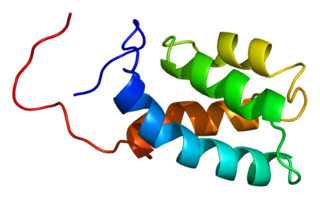
Parkin is a 465-residue E3 ubiquitin ligase that plays a critical role in ubiquitination- the process whereby molecules are covalently labelled with ubiquitin (Ub) and directed towards degradation in proteasomes or lysosomes. Ubiquitination involves the sequential action of three enzymes. First, an E1 ubiquitin-activating enzyme binds to inactive Ub in eukaryotic cells via a thioester bond and mobilises it in an ATP-dependent process. Ub is then transferred to an E2 ubiquitin-conjugating enzyme before being conjugated to the target protein via an E3 ubiquitin ligase. There exists a multitude of E3 ligases, which differ in structure and substrate specificity to allow selective targeting of proteins to intracellular degradation.

Mowat–Wilson syndrome is a rare genetic disorder that was clinically delineated by Dr. D. R. Mowat and Dr. M. J. Wilson in 1998.

Beta-synuclein is a protein that in humans is encoded by the SNCB gene.

Protein deglycase DJ-1, also known as Parkinson disease protein 7, is a protein which in humans is encoded by the PARK7 gene.

Pre-mRNA-processing-splicing factor 8 is a protein that in humans is encoded by the PRPF8 gene.

Ataxin-2 is a protein that in humans is encoded by the ATXN2 gene. Mutations in ATXN2 cause spinocerebellar ataxia type 2 (SCA2).

Dynamin-like 120 kDa protein, mitochondrial is a protein that in humans is encoded by the OPA1 gene. This protein regulates mitochondrial fusion and cristae structure in the inner mitochondrial membrane (IMM) and contributes to ATP synthesis and apoptosis, and small, round mitochondria. Mutations in this gene have been implicated in dominant optic atrophy (DOA), leading to loss in vision, hearing, muscle contraction, and related dysfunctions.

Peripherin-2 is a protein, that in humans is encoded by the PRPH2 gene. Peripherin-2 is found in the rod and cone cells of the retina of the eye. Defects in this protein result in one form of retinitis pigmentosa, an incurable blindness.

PRP31 pre-mRNA processing factor 31 homolog , also known as PRPF31, is a protein which in humans is encoded by the PRPF31 gene.

Glucosidase 2 subunit beta is an enzyme that in humans is encoded by the PRKCSH gene.

U4/U6 small nuclear ribonucleoprotein Prp3 is a protein that in humans is encoded by the PRPF3 gene.

Chloride channel 7 alpha subunit also known as H+/Cl− exchange transporter 7 is a protein that in humans is encoded by the CLCN7 gene. In melanocytic cells this gene is regulated by the Microphthalmia-associated transcription factor.

Probable cation-transporting ATPase 13A2 is an enzyme that in humans is encoded by the ATP13A2 gene that is involved in the transport of divalent transition metal cations. It appears to protect cells from manganese and zinc toxicity, possibly by causing cellular efflux and/or lysosomal sequestration; and from iron toxicity, possibly by preserving lysosome integrity against iron-induced lipid peroxidation. However, it potentiates the toxic effects of cadmium and nickel on developing neurites, and of the widely used herbicide paraquat possibly by increasing polyamine uptake.

Parkin coregulated gene protein is a protein that in humans is encoded by the PACRG gene.

Oxygen-regulated protein 1 also known as retinitis pigmentosa 1 protein (RP1) is a protein that in humans is encoded by the RP1 gene.

Non-imprinted in Prader-Willi/Angelman syndrome region protein 1 is a protein that in humans is encoded by the NIPA1 gene. This gene encodes a potential transmembrane protein which functions either as a receptor or transporter molecule, possibly as a magnesium transporter. This protein is thought to play a role in nervous system development and maintenance. Alternative splice variants have been described, but their biological nature has not been determined. Mutations in this gene have been associated with the human genetic disease autosomal dominant spastic paraplegia 6.

Ubiquinone biosynthesis protein COQ9, mitochondrial, also known as coenzyme Q9 homolog (COQ9), is a protein that in humans is encoded by the COQ9 gene.

Forkhead box protein E3 (FOXE3) also known as forkhead-related transcription factor 8 (FREAC-8) is a protein that in humans is encoded by the FOXE3 gene located on the short arm of chromosome 1.

Andrew Singleton is a British neurogeneticist currently working in the USA. He was born in Guernsey, the Channel Islands in 1972, where he lived until he was 18 years old. His secondary education was conducted at the Guernsey Grammar School. He earned a first class degree in Applied Physiology from Sunderland University and his PhD in neuroscience from the University of Newcastle upon Tyne where he studied the genetics of Alzheimer's disease and other dementias at the Medical Research Council (MRC) Neurochemical Pathology Unit. He moved to the United States in 1999, where he began working at the Mayo Clinic in Jacksonville, Florida studying the genetic basis of Parkinson's disease, ataxia, and dystonia. He moved to the National Institutes of Health in 2001 to head the newly formed Molecular Genetics unit within the Laboratory of Neurogenetics. In 2006 he took over as chief of the Laboratory of Neurogenetics. He is now an NIH Distinguished Investigator in the intramural program at the National Institute on Aging (NIA).
Parkinson's disease (PD) is a degenerative disorder of the central nervous system. Most people with PD have idiopathic Parkinson's disease. A small proportion of cases, however, can be attributed to known genetic factors. Other factors such as environmental toxins, herbicides, pesticides, and fungicides, have been associated with the risk of developing PD, but no causal relationships have been proven.


















